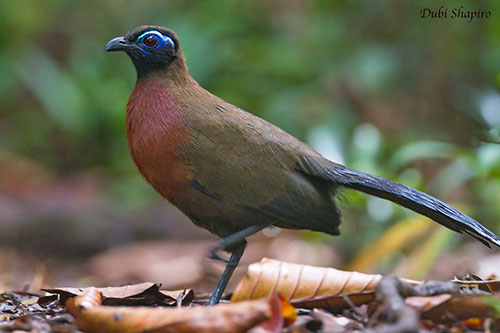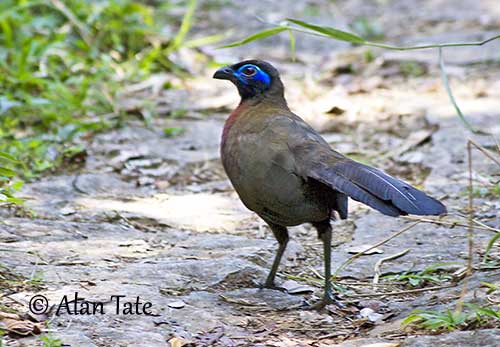
REPRODUCTION OF THIS SPECIES:
From some observations, chicks can be seen in the nest in October/November.
The Red-breasted Coua builds a bowl-shaped nest with woven twigs, placed in epiphytic fern or palm, about 2-4 metres above the ground.
The female lays two white eggs. No further information.
PROTECTION / THREATS / STATUS:
The Red-breasted Coua can be fairly common locally. It has restricted range but it occurs in several protected areas.
The population appears to be stable, as long as suitable forest habitat still exists in Madagascar.
The Red-breasted Coua is not globally threatened and currently evaluated as Least Concern.
Fr: Coua de Serrès - Coua de Serre
Ang: Red-breasted Coua
All: Rotbrust-Seidenkuckuck
Esp: Cúa Pechirrojo
Ita: Cua pettorosso
Nd: Vruchtencoua
Sd: rödbröstad koua
Mal: Koa
Photographers:
Dubi Shapiro
Dubi Shapiro Photo Galleries & Dubi Shapiro's Pictures on IBC
Alan & Ann Tate
AA Bird Photography
Text by Nicole Bouglouan
Sources:
HANDBOOK OF THE BIRDS OF THE WORLD vol 4 by Josep del Hoyo-Andrew Elliott-Jordi Sargatal - Lynx Edicions - ISBN: 8487334229
Cuckoos of the World Par Johannes Erritzøe, Clive F. Mann, Frederik Brammer, Richard A. Fuller – Editeurs A&C Black, 2012 – ISBN: 1408142678, 9781408142677
Birds of the Indian Ocean Islands Par Ian Sinclair, Olivier Langrand - ISBN: 1868729567, 9781868729562- Editeur: Struik, 2003
The Cuckoos Par Robert B. Payne – Editeur : OUP Oxford, 2005 – ISBN : 0191513555, 9780191513558
Birds of Madagascar: A Photographic Guide Par Pete Morris, Frank Hawkins – ISBN: 0300077556, 9780300077551- Editeur: Yale University Press, 1998
CREAGUS - CUCKOOS & ALLIES - Cuculidae
Red-Breasted Coua
Coua serriana
Cuculiformes Order – Cuculidae Family
INTRODUCTION:
The Red-breasted Coua is endemic to Madagascar, but it is only present in E and NE of the island where it frequents the undisturbed rainforest.
It is a large, stocky, long-tailed, terrestrial bird, very secretive and shy. It is usually found alone or in pairs, feeding on the ground by walking while searching for insects and small fallen fruits beneath the trees.
The Red-breasted Coua has very restricted range, but it occurs in several protected areas. The species is not currently threatened.
DESCRIPTION OF THE BIRD:
Biometrics:
Length: 42 cm
Weight: 298 g
The Red-breasted Coua has bronze to green-brown upperparts, but head and nape are darker. There is a coppery wash on mantle and upper back. Flight feathers and long tail are blue-black.
On the underparts, chin and throat are black. The breast is dark rufous and gives the bird its name. Rest of underparts is mostly blackish-brown.
On the dark head, we can see a conspicuous area of blue, bare skin around the eye.
The bill is black. The eyes are deep brown or red, surrounded by blue eyering. Legs and feet are dark grey.
Male and female are similar.

The juvenile has bronze upperparts with pale buff spotting. On the upperwings, coverts and flight feathers have buff edges. The tail is dull black.
On the underparts, throat and belly are olive. The breast is dull chestnut.
The bare skin around the eye is dull blue. The bill is pale with dark tip.
RANGE:
The Red-breasted Coua occurs mainly in E and NE Madagascar, from N Onive R to Andapa Basin, E to Masaola Peninsula and W through Tsaratanana massif to Sambirano and Daraina regions.
HABITAT:
The Red-breasted Coua frequents mainly the undisturbed evergreen humid forest, and can be seen from sea-level up to 1,250 metres of elevation.
CALLS AND SONGS: SOUNDS BY XENO-CANTO
The Red-breasted Coua is noisy during the breeding season. The common call is a high-pitched, descending whistle, often repeated and ending in a soft growl “cheeoow-ugh”. It also gives a high-pitched, melodious “tee-oooo”. The alarm call is a harsh, resonant “eeowll” note. Individuals usually respond to each other’s calls.
BEHAVIOUR IN THE WILD:
The Red-breasted Coua feeds on insects and small fruits usually taken on the ground while walking and running both on ground and horizontal branches. It often feeds beneath other fruit-eater birds and takes the fallen fruits.
When threatened, it runs with horizontal body into the vegetal cover.
Like other couas, it is frequently observed sunbathing in sunny spots on the forest floor. The feathers are ruffed, the wings are dropped and the tail is widely fanned.
The breeding behaviour of the Red-breasted Coua is poorly known. However, we can suggest that the bright blue bare skin around the eye and the long tail feathers are enhanced by adapted postures during the courtship displays.
The Red-breasted Coua is resident on the island.
It rarely flies, and usually prefers to run to reach the vegetal cover when alarmed.
